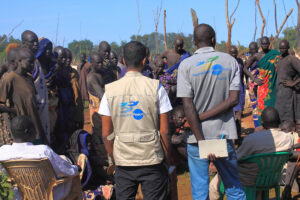(This is section 39 of the World Beyond War white paper A Global Security System: An Alternative to War. Continue to preceding | following section.)

Using the Blue Helmets, the UN is already stretched to fund 17 peacekeeping missions around the world, putting out or damping fires that could spread regionally or even globally. While they are, at least in many cases, doing a good job under very difficult conditions, the UN needs to become far more proactive in foreseeing and preventing conflicts where possible, and quickly and nonviolently intervening in conflicts that have ignited in order to put out the fires quickly.
Forecasting
Maintain a permanent expert agency to monitor potential conflicts around the world and recommend immediate action to the Security Council or the Secretary General, beginning with:
Pro-active Mediation Teams
Maintain a permanent set of mediation experts qualified in language and cultural diversity and the latest techniques of non-adversarial mediation to be dispatched rapidly to States where either international aggression or civil war looks imminent. This has started with the so-called Standby Team of Mediation Experts who act as on-call advisers to peace envoys around the world on issues such as mediation strategy, power-sharing, constitution-making, human rights and natural resources.note43
Align Early With Indigenous Nonviolent Movements
To date the UN has shown little understanding of the power that nonviolent movements within countries can exercise to prevent civil conflicts from becoming violent civil wars. At the least, the UN needs to be able to assist these movements by pressuring governments to avoid violent reprisals against them while bringing UN mediation teams to bear. The UN needs to engage with these movements. When this is deemed difficult due to concerns about infringing on national sovereignty, the UN can do the following.
Peacekeeping
Maintain the current Blue Helmets peacekeeping operations and enhanced capability for long-term missions as the last resort approach and with increased accountability to a democratically reformed UN. In addition, the armed peacekeeping operations must be understood as a clear transitional step toward ultimately relying on more effective, viable nonviolent alternatives.
Rapid Reaction Force to Supplement the Blue Helmets
All peacekeeping missions must be approved by the Security Council. The UN’s peacekeeping forces, the Blue Helmets, are recruited primarily from the developing nations. Several problems make them less effective than they could be. First, it takes several months to assemble a peacekeeping force, during which time the crisis can escalate dramatically. A standing, rapid reaction force which could intervene in a matter of days would solve this problem. Other problems with the Blue Helmets stem from using national forces and include: a disparity of participation, armaments, tactics, command and control, and rules of engagement.
Coordinate with Civilian-Based Nonviolent Intervention Agencies
Nonviolent, civilian-based peacekeeping teams have existed for over twenty years, including the largest, the Nonviolent Peaceforce (NP), headquartered in Brussels. The NP currently has observer status at the UN and participates in discussions of peacekeeping. These organizations, including not only NP but also Peace Brigades International, Christian Peacemaker Teams and others, can sometimes go where the UN cannot and thus can be effective in particular situations. The UN needs to encourage these activities and help fund them.The UN can also cooperate with other INGOs such as International Alert, Search for Common Ground, the Muslim Voice for Peace, the Jewish Voice for Peace, the Fellowship of Reconciliation, and many others by enabling their efforts to intervene early on in conflict areas.
(Continue to preceding | following section.)
We want to hear from you! (Please share comments below)
How has this led you to think differently about alternatives to war?
What would you add, or change, or question about this?
What can you do to help more people understand about these alternatives to war?
How can you take action to make this alternative to war a reality?
Please share this material widely!
Related posts
See other posts related to “Managing International and Civil Conflicts”
See full table of contents for A Global Security System: An Alternative to War
Notes:
43. http://www.un.org/en/peacekeeping/operations/financing.shtml (return to main article)









2 Responses
See “The ‘Gaping Hole’ in the UN for Sustaining Peace”
http://peaceoperationsreview.org/thematic-essays/the-gaping-hole-in-the-un-for-sustaining-peace/
See “Missed Opportunities: Gender and the UN’s Peacebuilding and Peace Operations Reports”
http://peaceoperationsreview.org/thematic-essays/missed-opportunities-gender-and-the-uns-peacebuilding-and-peace-operations-reports/